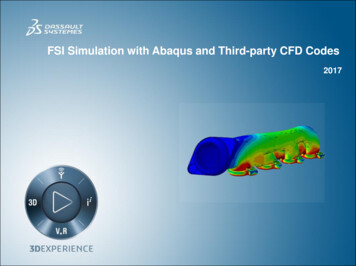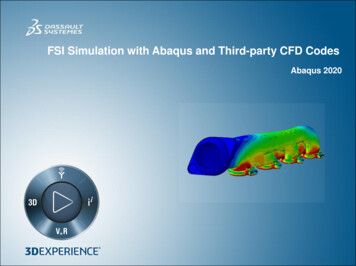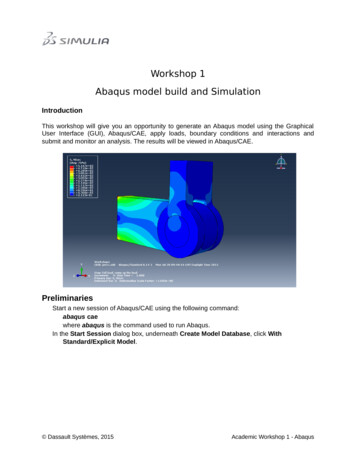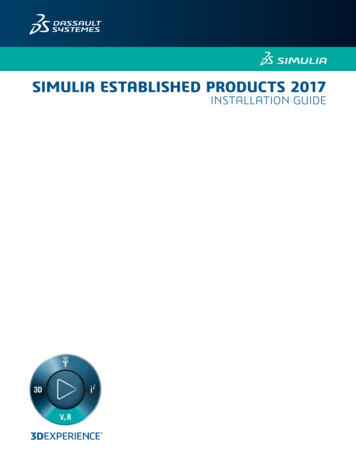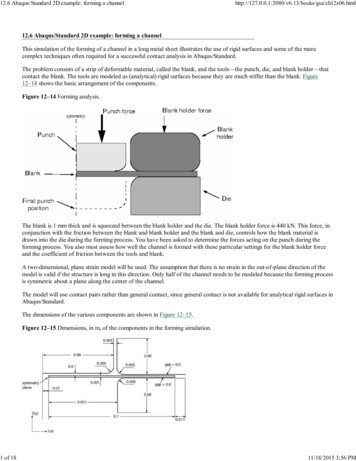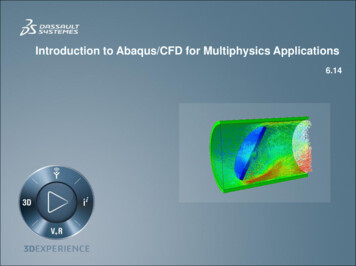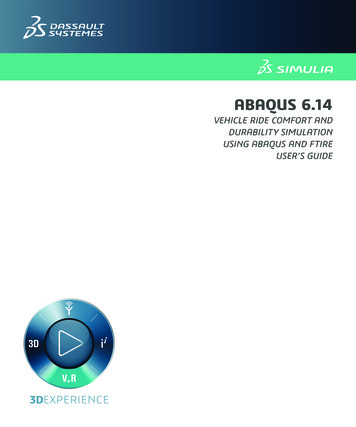
Transcription
FSI Simulation with Abaqus and Third-party CFD CodesAbaqus 2018
About this CourseCourse objectivesUpon completion of this course you will be able to:Evaluate FSI applicationsCreate compatible CSM and CFD models for FSIRun FSI problemsUnderstand co-simulation strategiesTargeted audienceThis seminar is recommended for both structural and CFD engineers with an interest in evaluating andanalyzing real world FSI applications.PrerequisitesNone1 day
Day 1Lecture 1IntroductionLecture 2Technical DetailsLecture 3Conducting an FSI Simulation using Abaqus and STAR-CCM Workshop 1 Antilock Braking System (Abaqus STAR-CCM )Lecture 4Classifying FSI ApplicationsWorkshop 2 Stead-State Flow in an Exhaust Manifold (Abaqus STAR-CCM )Lecture 5Miscellaneous Topics
Additional MaterialAppendix 1An Overview of CFD for Structural Analysts
SIMULIASIMULIA is the Dassault Systèmes brand for Realistic Simulation solutionsPortfolio of established, best-in-class productsAbaqus, Isight, Tosca, fe-safe, Simpack* Included in extended licensing pool
SIMULIA’s Power of the PortfolioAbaqus Routine and Advanced SimulationLinear and Nonlinear, Static and DynamicThermal, Electrical, AcousticsExtended Physics through Co-simulationModel Preparation and VisualizationIsight Process IntegrationDesign OptimizationParametric OptimizationSix Sigma and Design of ExperimentsTosca Non-Parametric Optimization Structural and Fluid Flow Optimization Topology, Sizing, Shape, Bead Optimizationfe-safe Durability Simulation Low Cycle and High Cycle Fatigue Weld, High Temperature, Non-metallicsSimpack 3D Multibody Dynamics Simulation Mechanical or Mechatronic Systems Detailed Transient Simulation (Offlineand Realtime)Realistic Human SimulationHigh Speed Crash & ImpactNoise & VibrationMaterial CalibrationWorkflow AutomationDesign ExplorationConceptual/Detailed DesignWeight, Stiffness, StressPressure Loss ReductionSafety FactorsCreep-Fatigue InteractionWeld FatigueComplete System Analyses(Quasi-)Static, Dynamics, NVHFlex Bodies, AdvancedContact
Join the Community!How can you maximize the robust technology of the SIMULIA Portfolio ?Go to www.3ds.com/slcto log in or join!
SIMULIA ia/services/training-courses/
Legal NoticesThe software described in this documentation is available only under license from Dassault Systèmesor its subsidiaries and may be used or reproduced only in accordance with the terms of such license.This documentation and the software described in this documentation are subject to change withoutprior notice.Dassault Systèmes and its subsidiaries shall not be responsible for the consequences of any errors oromissions that may appear in this documentation.No part of this documentation may be reproduced or distributed in any form without prior writtenpermission of Dassault Systèmes or its subsidiaries. Dassault Systèmes, 2017Printed in the United States of America.Abaqus, the 3DS logo, and SIMULIA are trademarks or registered trademarks of Dassault Systèmes orits subsidiaries in the US and/or other countries.Other company, product, and service names may be trademarks or service marks of their respectiveowners. For additional information concerning trademarks, copyrights, and licenses, see the LegalNotices in the SIMULIA User Assistance.
Revision StatusLecture 111/17Updated for Abaqus 2018Lecture 211/17Updated for Abaqus 2018Lecture 311/17Updated for Abaqus 2018Lecture 411/17Updated for Abaqus 2018Lecture 511/17Updated for Abaqus 2018Appendix 111/17Updated for Abaqus 2018Workshop 111/17Updated for Abaqus 2018Workshop 211/17Updated for Abaqus 2018
Lesson 1: Introductionwww.3ds.com Dassault SystèmesLesson content:Multiphysics / Multiscale SimulationSIMULIA MultiphysicsWhat is Co-Simulation?Co-Simulation ApplicationsSIMULIA Co-SimulationCFD Co-Simulation with AbaqusFluid-Structure InteractionFSI ApplicationsFSI ExamplesConjugate Heat Transfer between Solid and FluidsCHT ApplicationsCHT ExampleFSI/CHT Co-Simulation Attributes40 minutesL1.1
Lesson 2: Technical Detailswww.3ds.com Dassault SystèmesLesson content:What is Co-Simulation?Monolithic vs Segregated SolutionOvercoming Numerical ChallengesDefinitionsTechnical ApproachDetermining the Coupling Step SizeCommon Coupling StrategiesUpdating the CFD DomainSoftware Architecture40 minutesL2.1
Lesson 3: Conducting an FSI Simulation using AbaqusLesson content:www.3ds.com Dassault SystèmesSuggested Generic WorkflowFSI Workflow using STAR-CCM Workshop PreliminariesWorkshop 1: Antilock Braking System (Abaqus STAR-CCM )1.5 hoursL3.1
Lesson 4: Classifying FSI Applicationswww.3ds.com Dassault SystèmesLesson content:Unidirectional Coupled AnalysisBidirectional Coupled AnalysisFile-Based Sequential CouplingEstimating Coupling StrengthWorkshop 2: Stead-State Flow in an Exhaust Manifold (Abaqus STAR-CCM )2.5 hoursL4.1
Lesson 5: Miscellaneous Topicswww.3ds.com Dassault SystèmesLesson content:Co-Simulation DirectorThe *CO-SIMULATION optionRestart AnalysisConvergenceWorkflow between CSS and SolversManually Starting the CSS Director Process45 minutesL5.1
Appendix 1: An Overview of CFD for Structural Analystswww.3ds.com Dassault SystèmesAppendix content:IntroductionGoverning Equations for Fluid DynamicsComputational Fluid DynamicsFluid PropertiesCFD Modeling45 minutesA1.1
CFD Co -Simulation with Abaqus Fluid -Structure Interaction FSI Applications FSI Examples Conjugate Heat Transfer between Solid and Fluids CHT Applications CHT Example FSI/CHT Co -Simulation Attributes Lesson 1: Introduction 40 minutes . es L2. 1 Lesson content: What is Co -Simulation ? .
